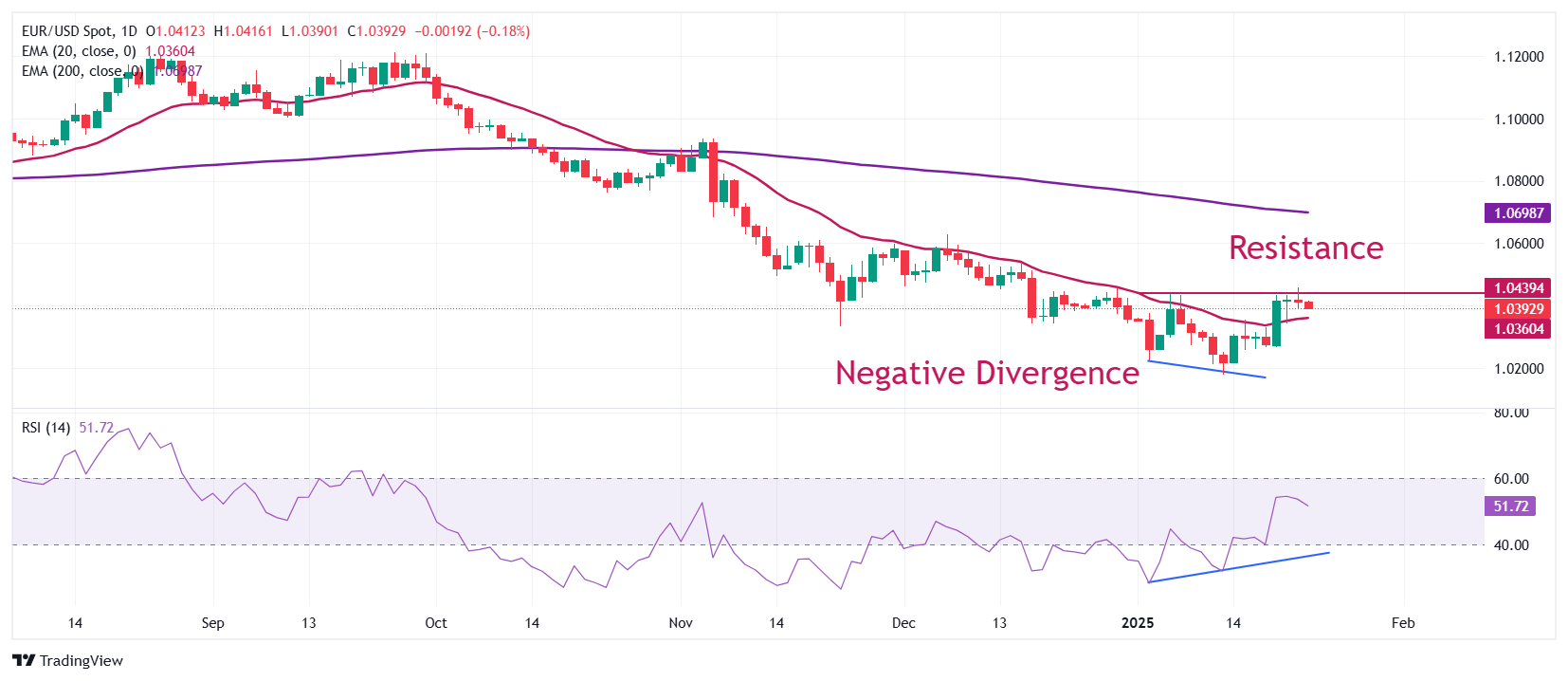EUR/USD trades cautiously as investors assess consequences of Trump’s tariffs

EUR/USD falls back to near 1.0400 as the US Dollar gains ground amid concerns over global economic growth with Trump’s tariffs.
ECB President Lagarde has advised that Europe should be prepared to respond to Trump’s tariff hikes.
The Fed and the ECB are set to announce their first monetary policy decision of 2025 next week.
EUR/USD ticks lower to near 1.0400 in Thursday’s European session as the US Dollar (USD) gains ground. The US Dollar Index (DXY), which tracks the Greenback’s value against six major currencies, extends its recovery to near 108.40 from the two-week low of 107.75 posted on Wednesday. The Greenback bounces back as the market sentiment turns slightly cautious, with investors assessing the consequences of United States (US) President Donald Trump’s tariffs on economic growth.
Trump has threatened 25% tariff hikes on Canada and Mexico and 10% on China, which will come into effect on February 1. He also plans to impose tariffs on Europe after accusing the bloc of being "very, very bad to us". Trump’s tariff hike approach appears to be more gradual than what market participants had anticipated. However, they would still be unfavorable to global economic growth.
On Wednesday, European Central Bank (ECB) President Christine Lagarde commented on CNBC that Trump’s decision not to swiftly impose tariffs was a "smart approach" because blanket levies don’t necessarily give you the “results that you expect." Lagarde warned that Europe must “anticipate what will happen” and be “prepared in order to respond,” as Trump’s tariffs would be “selective” and “focused.”
Daily digest market movers: EUR/USD ticks lower ahead of Eurozone-US flash PMI for January
EUR/USD edges lower on Thursday, with investors focusing on flash private Eurozone and the US Purchasing Managers Index (PMI) data for January, which will be published on Friday. Eurozone HCOB PMI report, compiled by S&P Global, is expected to show that overall business activity continued to contract but at a slower pace. The HCOB Composite PMI is estimated to come in slightly higher at 49.7, compared to 49.6 in December.
On the US front, economists expect overall business activity to have expanded almost at a steady pace. Activities in the manufacturing sector are estimated to have contracted again but at a slower pace. Meanwhile, the service sector activity is expected to expand moderately.
Investors should also brace for significant volatility in the next week as the Federal Reserve (Fed) and the ECB will announce their first monetary policy decisions this year. The Fed is certain to keep interest rates in the range of 4.25%-4.50%, according to the CME FedWatch tool. Meanwhile, traders have fully priced in a 25-basis points (bps) interest rate reduction by the ECB.
Traders also expect the ECB to cut its Deposit Facility rate in each of its next four policy meetings. ECB policymaker and Finnish central bank governor Olli Rehn said on Wednesday that he is now confident that “inflation will stabilize at the target as predicted” and monetary policy will “stop being restrictive” in the near future. However, he refrained from endorsing market expectations and argued that policy decisions will be determined meeting by meeting.
Technical Analysis: EUR/USD faces pressure around 1.0460
EUR/USD struggles to extend its recovery above the immediate resistance of 1.0460, which was initiated from a two-year low of 1.0175 reached on January 13. The major currency pair bounced back after a divergence in momentum and price action. The 14-day Relative Strength Index (RSI) formed a higher low, while the pair made lower lows.
The near-term outlook of the shared currency pair has improved as it holds above the 20-day Exponential Moving Average (EMA), which trades around 1.0360. Meanwhile, the longer-term outlook is still bearish as the 200-day EMA at 1.0700 is sloping downwards.
Looking down, the January 13 low of 1.0175 will be the key support zone for the pair. Conversely, the psychological resistance of 1.0500 will be the key barrier for the Euro bulls.
* The content presented above, whether from a third party or not, is considered as general advice only. This article should not be construed as containing investment advice, investment recommendations, an offer of or solicitation for any transactions in financial instruments.



